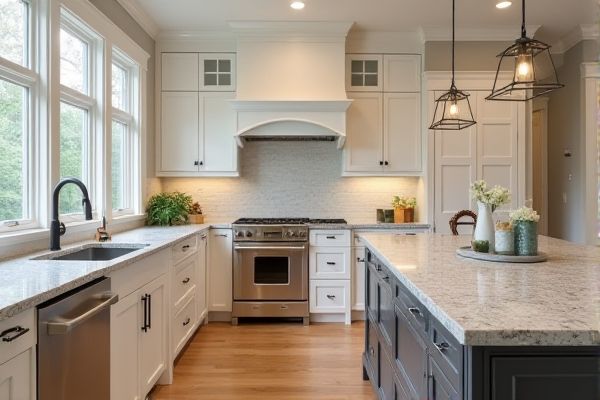
Wall pantry cabinets maximize vertical storage space by utilizing the height of your kitchen walls, ideal for storing dry goods and small appliances out of the way. Base pantry cabinets offer easy access and more countertop space by integrating storage at lower levels; explore this article to determine which pantry solution best fits Your kitchen needs.
Table of Comparison
| Feature | Wall Pantry Cabinet | Base Pantry Cabinet |
|---|---|---|
| Location | Mounted on the wall above countertop | Installed at floor level, under the countertop |
| Storage Capacity | Limited by height and depth (usually shallower) | Larger storage with deeper shelves |
| Accessibility | Easy access to frequently used items | Requires bending or pulling out shelves/drawers |
| Installation Height | Mounted 18-24 inches above countertop | Rest on the floor, aligning with countertop height |
| Design Impact | Keeps floor space open, enhances kitchen openness | Provides stable countertop support and more storage |
| Use Case | Ideal for storing lightweight, frequently used pantry items | Best for bulk storage and heavy items |
| Average Dimensions | 12-24 inches wide, 12-15 inches deep, 30-42 inches tall | 12-36 inches wide, 24-30 inches deep, 34-36 inches tall |
Introduction to Wall Pantry vs Base Pantry Cabinets
Wall pantry cabinets maximize vertical space by providing tall storage units mounted above countertops, ideal for storing dry goods and kitchen essentials at eye level. Base pantry cabinets, positioned under countertops, offer deep drawers and shelves perfect for heavier items and bulkier kitchen supplies, optimizing lower kitchen areas. Your choice depends on kitchen layout and accessibility preferences to enhance storage efficiency.
Key Differences Between Wall and Base Pantry Cabinets
Wall pantry cabinets are mounted above countertops, offering easy access to frequently used items while saving floor space, whereas base pantry cabinets sit on the floor and provide larger storage capacity with deeper shelves for bulkier goods. Wall cabinets typically feature shallower depths, ranging from 12 to 24 inches, making them ideal for lighter, smaller items, while base cabinets generally have depths of 24 to 30 inches, accommodating larger containers and appliances. The height and accessibility differences impact kitchen workflow and storage efficiency, with wall pantries optimizing vertical space and base pantries delivering substantial under-counter organization.
Design and Space Efficiency
Wall pantry cabinets maximize vertical space, making them ideal for smaller kitchens by offering ample storage without occupying floor area. Base pantry cabinets provide easier access to heavy or bulky items, utilizing lower kitchen space more effectively for larger storage capacity. Your choice depends on whether you prioritize countertop space and vertical organization or ease of reach and volume.
Storage Capacity Comparison
Wall pantry cabinets typically offer less storage capacity compared to base pantry cabinets due to their elevated placement and smaller size constraints. Base pantry cabinets provide more extensive storage options with deeper shelves and easier access, maximizing your kitchen's utility. Choosing the right pantry cabinet depends on your available space and the volume of items you need to store efficiently.
Accessibility and Convenience
Wall pantry cabinets offer easy-to-reach storage, ideal for frequently used items, enhancing your kitchen's accessibility by keeping essentials at eye level. Base pantry cabinets provide deeper storage space and accommodate heavier items, making them convenient for bulkier goods but requiring more bending or kneeling. Choosing between them depends on your preference for quick access versus capacity and ergonomic convenience.
Installation Requirements and Complexity
Wall pantry cabinets require secure mounting to wall studs at appropriate heights, often demanding precise measurements and support for weight distribution. Base pantry cabinets need a level floor surface and proper alignment with adjacent cabinetry, posing challenges in uneven floors or tight kitchen spaces. Your choice affects installation complexity, with base cabinets generally easier to install but wall cabinets offering more flexibility in layout.
Cost Analysis: Wall vs Base Pantry
Wall pantry cabinets typically cost less per linear foot than base pantry cabinets due to simpler installation and reduced material requirements. Base pantry cabinets involve higher expenses from reinforced flooring and customized shelving to support heavier storage loads. Considering long-term value, base pantries offer increased storage capacity but require a larger initial investment compared to wall-mounted alternatives.
Aesthetic Impact on Kitchen Design
Wall pantry cabinets create a sleek, streamlined look by utilizing vertical space and keeping countertops clear, enhancing the kitchen's overall openness and modern appeal. Base pantry cabinets offer a more grounded, traditional aesthetic with easy access at counter height, blending functionality with warm, inviting design elements. Your choice influences the kitchen's visual balance and can either accentuate height or emphasize horizontal flow.
Pros and Cons of Wall Pantry Cabinets
Wall pantry cabinets maximize vertical storage space, making them ideal for small kitchens or areas with limited floor space. They often offer easy access to frequently used items without bending, but can be challenging to reach higher shelves and may require step stools. Your choice depends on whether ease of access or maximized floor space is more important for your kitchen layout.
Pros and Cons of Base Pantry Cabinets
Base pantry cabinets offer easy access to stored items due to their lower height, making it convenient for You to organize heavy or bulky kitchen supplies. Their countertop space enhances kitchen functionality for food prep, but the limited vertical storage can reduce overall capacity compared to wall pantry cabinets. Accessibility and stable storage make base pantries ideal for frequently used items, though they may not maximize available wall space efficiently.
 homyna.com
homyna.com